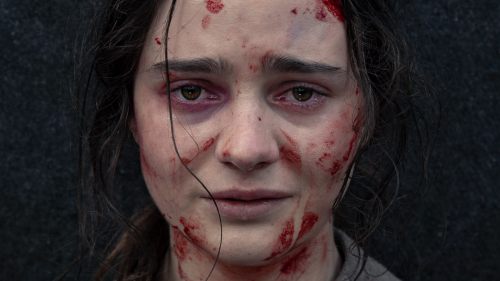THE NIGHTINGALE Stares In The Face Of Pain, And It Wouldn’t Work Any Other Way
The Nightingale is in theaters now. Get your tickets here.
In one of The Nightingale’s most galvanizing and confronting scenes, it’s hard to know who deserves more acclaim: Jennifer Kent or Aisling Franciosi. The Australian filmmaker helms her long-awaited sophomore feature following the success of The Badabook; the Irish-Italian actress steps into her first leading feature role, and the results demand attention. Let’s be clear — the sequence in question is both harrowing and horrifying. Its violence in no way seeks, earns, deserves or receives cheers. In a movie filled with difficult sights, this proves one of its most challenging. But forcing audiences to watch, to experience the ordeal endured by its protagonist, and to grapple with the discomfort it incites serves an important purpose.
As Irish convict Clare (Franciosi) falls prey to British officer, Hawkins (Sam Claflin), who refuses to release her from a seven-year sentence long-completed in the penal colony of Tasmania circa 1825, Kent trains the camera firmly at the young woman. Using Academy ratio images, the writer/director doesn’t relent, retaining the film’s fixed gaze as the scene continues. Her decision is pointed and powerful, focusing on aghast grimaces and anguished eyes. In Franciosi, she’s gifted a performance that goes beyond committed, leaving nothing unsaid through physicality alone. Her face, rather than her body, is the key, and neither Kent nor Franciosi let that detail fade.
In staging and shooting this scene, Kent is in ferocious form; the maelstrom of unfettered emotions coursing through her central character, as well as the visceral savagery of being a victim of such viciousness, couldn’t be more potent. Franciosi, best known for roles in TV series The Fall, Legends and Game of Thrones, puts in a performance that’s equally as brave and blistering, letting Clare’s pain seep from every pore in her body, Here, director and performer unite to achieve a common, essential goal: to convey the inescapable toll of a procession of shattering incidents, and of all other gross misuses of power. That’s The Nightingale in a nutshell, too — examining the historical and continuing subjugation of women, the violent oppression inflicted upon Australia’s Indigenous inhabitants, the cruelty and callousness of colonization, and the barbarity of ignoring all of the above, it lays bare the aggression, terror and inhumanity of coercing one’s will, be it upon another person, gender, race, community, country or history itself.
Wading into such murky, thorny territory requires tough choices, but watching it isn’t a matter of having a tough constitution. By now, nearly a year since The Nightingale first screened at the Venice Film Festival, its reputation precedes it; however Kent’s film is a raw, rewarding and resonant watch. Controversy has continued to cling to the movie whilst making the international rounds, including mass coverage of walkouts during its Australian festival screenings, though the fact that the overwhelming bulk of audiences stay silent in their seats hasn’t been given the same attention. Knowing that the majority of viewers see the film through is decidedly more pertinent and relevant than knowing that some don’t. It’s also emblematic of The Nightingale’s approach in action: facing complexity head-on, even at its most distressing and disturbing, rather than fleeing from it.
Clare’s plight in the aforementioned scene is just one instance in a long line of darkness. At the hands of Hawkins and his similarly snarling, merciless lackeys (including Damon Herriman), she weathers more. Repeatedly making her sing for their entertainment is the least of her assailants’ misdeeds, and that she has a husband (Michael Sheasby) and an infant daughter is not only of no concern to them —it’s the source of one of The Nightingale’s crucial turning points. Battered but not broken, when Clare steels herself for retribution for her suffering, she witnesses more atrocities still, including the dehumanizing treatment of Australia’s Aboriginal inhabitants. Enlisting the begrudging assistance of an Indigenous tracker, Billy (Baykali Ganambarr), she seeks out her chief tormentor, while trekking across hostile terrain made more so by the brutishness that blights the country’s colonial history. As the pair set out, Clare is as unwelcoming towards Billy as the British settlers that they both hate, though their shared traumas become evident throughout their journey.
As cinema’s own past has shown, difficult tales and their accompanying visuals don’t always justify their nastiness. The term “torture porn” exists for a reason. But The Nightingale couldn’t be further removed from that sentiment, or from trying to make a splash by filling its frames with harshness. There’s an enormous difference between depiction and thoughtful interrogation — and, just as the former doesn’t equate to an endorsement, the latter demonstrates the need to show and dissect horrors, rather than merely mention them. Accordingly, as meticulously researched by Kent with an emphasis on accurately representing life for women and Indigenous Australians in colonial times, unflinchingly conveying the lingering effects on the nation’s first peoples, and honestly burrowing into both individual and communal post-traumatic stress experiences, The Nightingale is deepened and emboldened by its context. To understand the extent of subjugation and persecution endured by the real-life figures that Claire and Billy represent — not individual people by any means, but embodying a broad yet authentic snapshot of Australian history — requires truly seeing it. And so, Kent refuses to look away.
It’s a simple move with complicated, uncompromising repercussions, all by design. Kent finds multiple ways to mirror her approach within the film itself: presenting clear-cut villains steeped in a hierarchical world of engrained power, arrogance and entitlement, and charting a straightforward quest through wild landscape that teems with intricacy and complexity not just in its flora and fauna, but in the events that blight its natural splendor. The feature’s purpose is to portray and question; to illustrate the violence so inherent to its setting, characters and country, as subjected upon women and Indigenous people specifically, and to ponder how anyone copes in the face of all of the above. That couldn’t be more important, and nor is the outcome that The Nightingale evokes. As the film stares down pain, making the audience confront deep-seated bleakness that many would rather overlook — and that, for centuries, largely has been — it asks our inner humanity to stare back.



